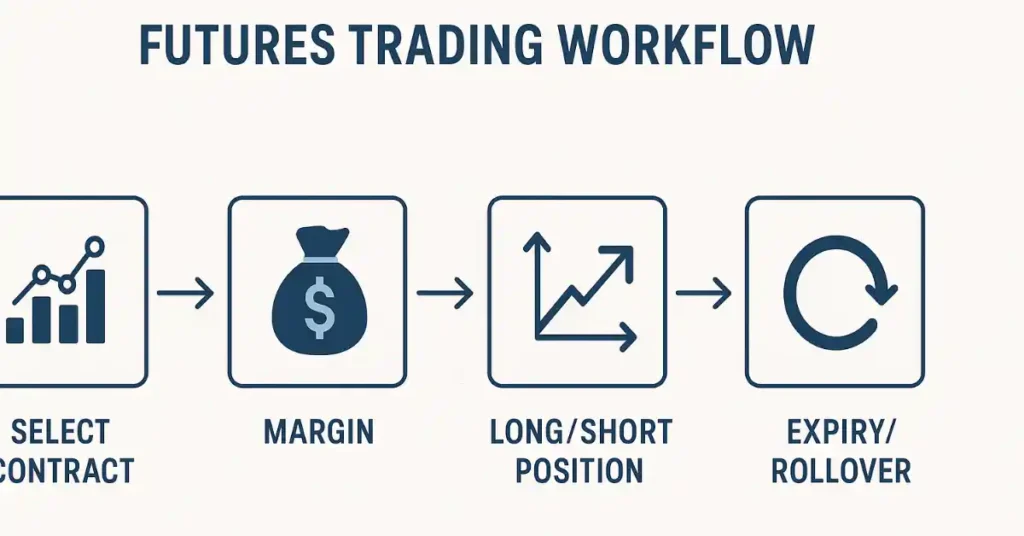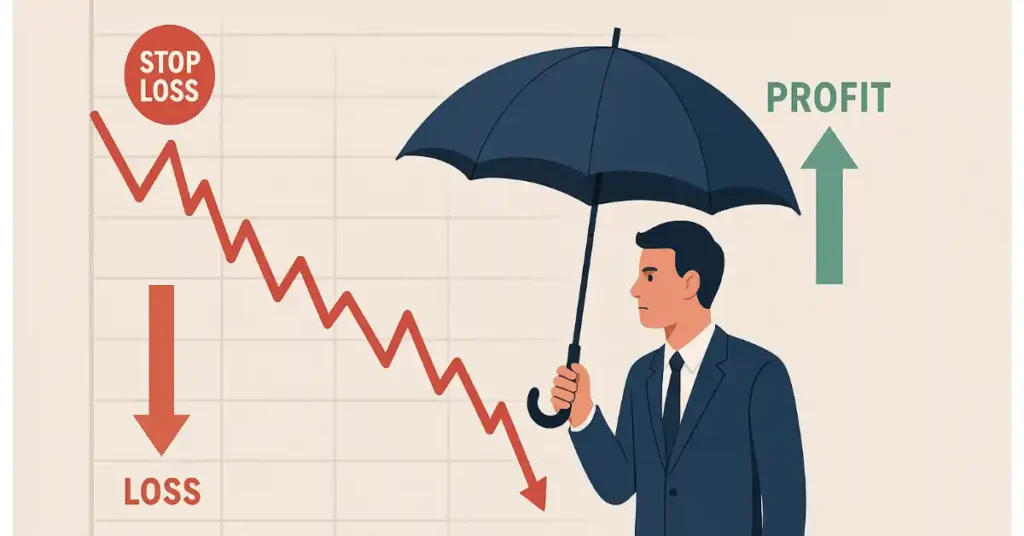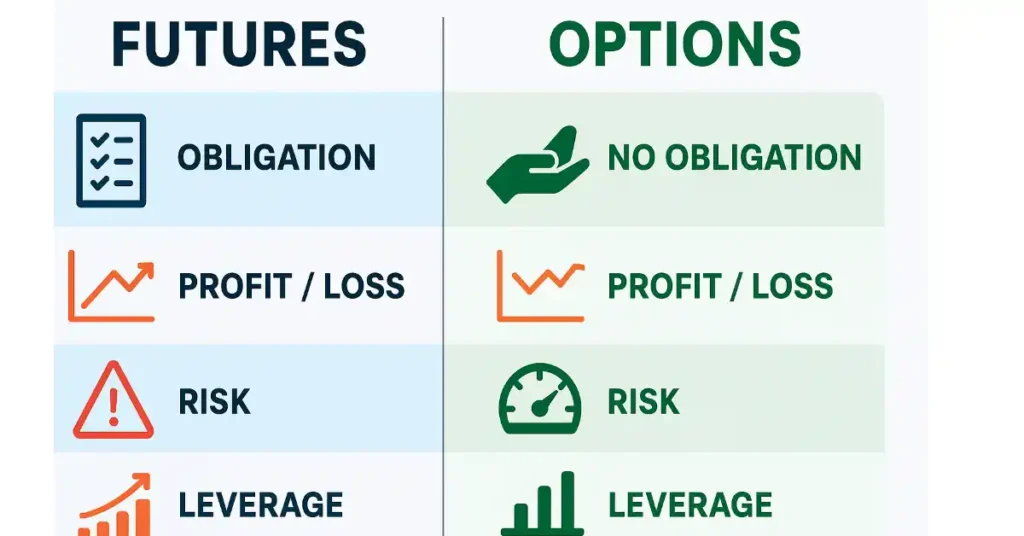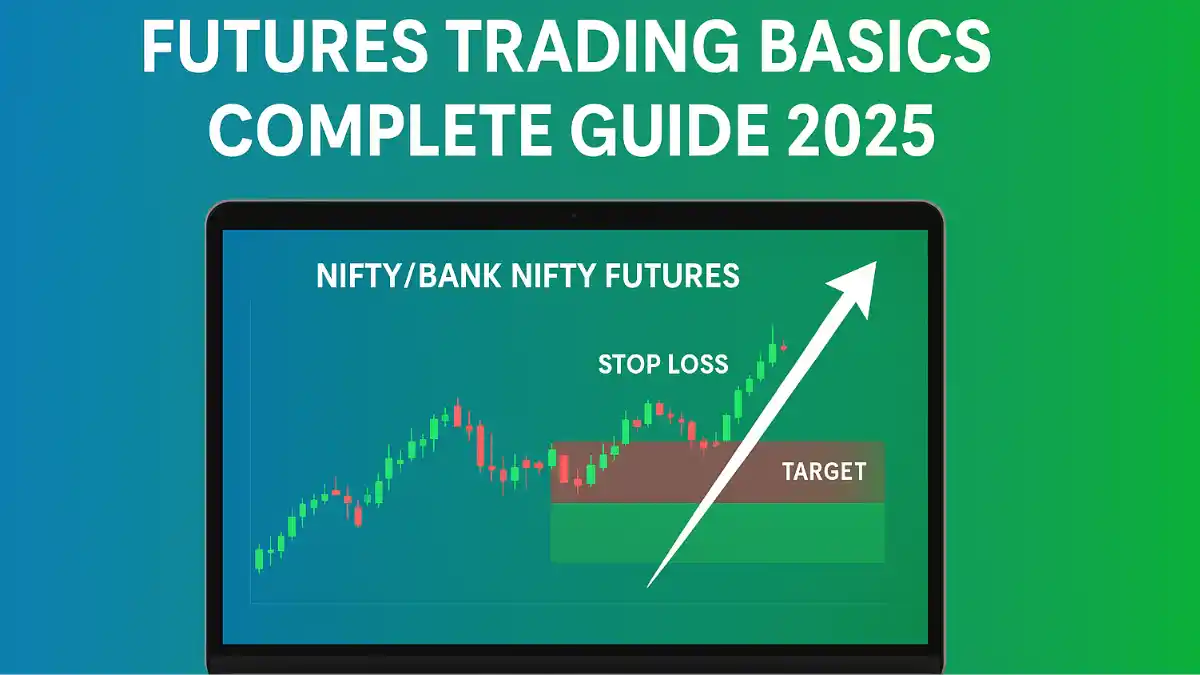Futures Trading Basics in Hindi-English mix. Guide on contracts, margin, leverage, hedging & strategies for beginners. SEO-friendly blog for 2025
Introduction to Futures Trading
Futures Trading एक financial agreement है जिसमें buyer और seller agree करते हैं कि वे किसी underlying asset (जैसे stock, index, commodity या currency) को एक pre-decided price और future date पर buy/sell करेंगे। यह contracts exchange-traded होते हैं जिससे पूरी प्रक्रिया standardized और transparent रहती है।
Investors futures का use दो मुख्य उद्देश्यों से करते हैं:
- Hedging: Market के uncertain moves से portfolio को सुरक्षित रखना।
- Speculation: Short-term price fluctuations से profit कमाना।
Futures market highly liquid और leverage-based है। यानि आप छोटे capital से बड़ा exposure ले सकते हैं। लेकिन leverage profit और loss दोनों को amplify करता है, इसलिए disciplined risk management बहुत जरूरी है।
India में futures trading NSE और BSE जैसे exchanges पर होती है। यहाँ stock, index, commodity और currency futures easily available हैं। Futures trading सिर्फ traders के लिए ही नहीं बल्कि corporates के लिए भी useful है। Exporters-importers currency futures से risk hedge करते हैं, जबकि manufacturers commodity futures का use cost stabilize करने के लिए करते हैं।
Beginners को पहले futures contracts की structure, margin requirements और MTM settlement समझना चाहिए। Demo trading और stop-loss use करना safe start का सबसे अच्छा तरीका है।
What Are Futures Contracts
Futures contract एक standardized agreement है जो exchange पर trade होता है। इसमें दो parties—buyer और seller—agree करते हैं कि वे future में किसी asset को fixed price पर buy/sell करेंगे।
Key Elements of a Futures Contract:
- Underlying Asset: Stock, index, commodity, या currency।
- Contract Size: Fixed lot quantity।
- Expiry Date: Contract की maturity।
- Price: तय की गई buying/selling price।
Settlement के दो तरीके हैं:
- Cash Settlement: Profit-loss cash में adjust।
- Physical Delivery: Actual asset deliver होता है (ज्यादातर commodities)।
Example: अगर trader Reliance Futures buy करता है और expiry तक Reliance का price बढ़ जाता है, तो उसे profit होगा। अगर price गिरता है तो loss होगा।
Futures contracts का फायदा यह है कि यह standardized होते हैं और exchange-traded होते हैं। इससे liquidity high और manipulation कम होता है। Hedgers और speculators दोनों के लिए यह tool useful है।
Beginners को पहले high-liquidity contracts जैसे Nifty Futures या Bank Nifty Futures से start करना चाहिए क्योंकि इनमे volume और trend ज्यादा clear रहता है।
Key Features of Futures Trading
Futures trading में कुछ ऐसे unique features हैं जो इसे other markets से अलग बनाते हैं।
Major Features:
- Leverage: कम capital से high exposure।
- Liquidity: Futures contracts high volume में trade होते हैं।
- Standardization: हर contract predefined specifications के साथ आता है।
- Transparency: Exchange-traded होने से prices reliable रहते हैं।
- Hedging & Speculation: दोनों purposes serve होते हैं।
- Short-Selling Possible: Price गिरने पर भी profit कमा सकते हैं।
Example: अगर Nifty Futures contract का value ₹10,00,000 है, तो trader सिर्फ 10% margin यानी ₹1,00,000 लगाकर contract में position ले सकता है।
Futures trading का सबसे बड़ा plus point leverage है। लेकिन leverage double-edged sword है क्योंकि यह profit और loss दोनों को multiple करता है।
Beginners को हमेशा stop-loss, position sizing और risk-reward ratio को ध्यान में रखकर futures trading करनी चाहिए। यह market बहुत opportunities provide करता है लेकिन बिना discipline loss भी बड़ा हो सकता है।
Types of Futures Contracts
Futures contracts कई categories में आते हैं:
- Stock Futures: Individual stocks जैसे Reliance, TCS, Infosys।
- Index Futures: Nifty 50, Bank Nifty।
- Commodity Futures: Gold, Silver, Crude Oil, Copper।
- Currency Futures: USD/INR, EUR/INR, GBP/INR।
- Interest Rate Futures: Government securities और bonds।
Use Cases:
- Stock और index futures सबसे liquid instruments हैं।
- Commodity futures manufacturers और traders के लिए cost hedge का tool हैं।
- Currency futures exporters-importers के लिए forex risk management का तरीका हैं।
Example:
- अगर exporter को डर है कि dollar गिर सकता है, तो वह USD/INR futures sell करके loss hedge कर सकता है।
- अगर jeweller को लगता है कि gold price बढ़ेगा, तो gold futures buy कर सकता है।
Futures contracts अलग-अलग traders और investors की जरूरत के अनुसार flexibility provide करते हैं। Beginners को पहले index futures से start करना चाहिए क्योंकि इनका movement ज्यादा predictable होता है।
How Futures Trading Works

Futures trading का mechanism step-by-step समझा जा सकता है:
- Trader एक futures contract select करता है।
- Contract buy (long) या sell (short) किया जाता है।
- Initial margin deposit करनी होती है।
- Profit या loss daily MTM (Mark-to-Market) settlement से adjust होता है।
- Expiry date पर contract close या next expiry में rollover किया जा सकता है।
Example:
अगर Nifty Futures का price 20,000 है और trader long position लेता है। Price 20,200 होने पर उसे profit होगा, और price 19,800 होने पर loss होगा।
Positions:
- Long Position: Price बढ़ने पर profit।
- Short Position: Price गिरने पर profit।
Futures trading leverage और volatility के कारण attractive है। लेकिन risk control करना equally जरूरी है। Beginners को हमेशा stop-loss और risk-reward ratio पर ध्यान देना चाहिए।
Margin and Leverage in Futures
Futures trading में margin और leverage core concepts हैं।
- Margin: Trader को position open करने के लिए total contract value का केवल कुछ प्रतिशत देना होता है। इसे Initial Margin कहते हैं।
- Leverage: Margin system की वजह से small capital से बड़ी exposure मिलती है।
Example:
अगर Reliance Futures contract value ₹5,00,000 है और margin requirement 10% है, तो trader सिर्फ ₹50,000 deposit करके position ले सकता है।
Types of Margin:
- Initial Margin: Position open करने के लिए।
- Maintenance Margin: Minimum balance जो account में रहना चाहिए।
- Variation Margin: MTM settlement के लिए।
Leverage profit को multiply करता है लेकिन losses को भी उतना ही amplify करता है। इसलिए beginners को leverage wisely use करना चाहिए।
Risk control के लिए strict stop-loss और limited exposure जरूरी है। Beginners को कभी भी पूरे capital से trade नहीं करना चाहिए।
Mark to Market (MTM) in Futures
Mark to Market (MTM) futures trading का सबसे important process है। इसमें रोज़ाना contract का profit और loss calculate करके trader के account में credit या debit किया जाता है।
How It Works:
अगर आप Nifty Futures 20,000 पर buy करते हैं और दिन के अंत में closing price 20,100 है, तो आपको 100 points का profit मिलता है। उसी तरह अगर closing price 19,900 है, तो उतना ही loss होगा।
Benefits of MTM:
- Real-time profit-loss clear होता है।
- Default risk कम हो जाता है।
- Daily settlement से transparency बनी रहती है।
Example:
एक trader Reliance Futures buy करता है और अगले दिन price बढ़ता है, तो उसका profit account में credit हो जाएगा। Price गिरने पर variation margin की demand आ सकती है।
MTM system futures market की integrity और transparency बनाए रखता है। Beginners को हमेशा daily settlement के लिए capital ready रखना चाहिए।
Expiry and Rollover in Futures
हर futures contract की एक fixed expiry होती है—monthly, bi-monthly या quarterly। Expiry date पर contract settle हो जाता है, या तो cash settlement या physical delivery से।
Rollover:
अगर trader को contract expiry के बाद भी position hold करनी है, तो वह current contract को close करके next expiry contract open करता है। इसे rollover कहते हैं।
Example:
अगर आपके पास Nifty October Futures हैं और आप November तक position रखना चाहते हैं, तो आप October contract sell करेंगे और November Futures buy करेंगे।
Important Points:
- Rollover करते समय price difference (spread) होता है।
- Expiry के आसपास contracts में ज्यादा volatility आ सकती है।
Beginners को rollover process समझना जरूरी है, खासकर अगर वे positional trading करते हैं। Intraday traders आमतौर पर rollover नहीं करते।
Hedging with Futures

Hedging futures trading का सबसे बड़ा advantage है। Hedging का मतलब है किसी existing portfolio या asset को market risk से बचाना।
How It Works:
मान लीजिए आपके पास ₹10 लाख का stock portfolio है। आपको लगता है market गिर सकता है। आप Nifty Futures sell करके अपने portfolio को protect कर सकते हैं।
अगर market गिरता है तो आपके portfolio में loss होगा, लेकिन futures sell position से profit मिलेगा। इस तरह overall risk कम हो जाएगा।
Use Cases:
- Exporters currency futures से forex risk hedge करते हैं।
- Farmers commodity futures से अपनी crop prices secure करते हैं।
- Investors index futures से अपने portfolios protect करते हैं।
Hedging profit कमाने से ज्यादा risk control का तरीका है। Beginners इसे जरूर समझें क्योंकि यह long-term stability के लिए helpful है।
Speculation in Futures
Speculation futures market का दूसरा बड़ा purpose है। इसमें traders सिर्फ price movement predict करके profit कमाने की कोशिश करते हैं।
Example:
अगर trader को लगता है कि Crude Oil price बढ़ेगा, तो वह crude oil futures buy करेगा। अगर price सच में बढ़ गया, तो उसे profit होगा।
Advantages:
- Short-term profits possible।
- High leverage quick returns ला सकता है।
Risks:
- गलत speculation से बड़ा loss हो सकता है।
- Leverage losses को multiple कर देता है।
Speculation futures trading में सबसे popular activity है। लेकिन beginners को बिना knowledge और strategy के speculation avoid करना चाहिए। Discipline और risk management के साथ speculation profitable हो सकता है।
Spread Trading in Futures
Spread trading का मतलब है दो related futures contracts में opposite positions लेकर price difference से profit कमाना।
Types of Spreads:
- Calendar Spread: Same asset, अलग expiry contracts।
- Inter-Commodity Spread: Different but related commodities।
- Inter-Market Spread: Same commodity in different markets।
Example:
Trader Nifty October Futures buy करता है और Nifty November Futures sell करता है। अगर दोनों contracts का price difference favorable होता है, तो profit मिलता है।
Spread trading का फायदा यह है कि इसमें risk speculative trades से कम होता है क्योंकि position partially hedge होती है।
Beginners के लिए यह advanced strategy है, लेकिन practice के बाद useful साबित हो सकती है।
Arbitrage in Futures
Arbitrage का मतलब है एक ही asset के price difference का फायदा उठाना।
Example:
अगर Reliance cash market में ₹2500 पर trade हो रहा है और futures market में ₹2520 पर, तो trader cash market में Reliance buy करके futures market में sell कर सकता है। Price difference profit बन जाएगा।
Features of Arbitrage:
- Risk-free profit (अगर properly execute हो)।
- बहुत fast execution जरूरी है।
- High capital requirement होता है।
Arbitrage से market efficiency improve होती है। Professionals और institutions arbitrage opportunities regularly use करते हैं।
Beginners arbitrage से सीख सकते हैं कि futures और cash market कैसे linked हैं।
Indicators in Futures Trading
Technical indicators futures trading में entry और exit points decide करने के लिए बहुत useful हैं।
Popular Indicators:
- Moving Averages (MA): Trend identify करने के लिए।
- Relative Strength Index (RSI): Overbought और oversold conditions।
- MACD: Momentum और crossover signals।
- Bollinger Bands: Volatility और price breakout signals।
Example:
अगर Nifty Futures RSI 30 से नीचे चला जाता है, तो यह oversold signal है। Price bounce होने की संभावना है।
Indicators alone काम नहीं करते। इन्हें support/resistance और volume analysis के साथ use करना चाहिए।
Beginners को 2–3 basic indicators से start करना चाहिए और overcomplicate नहीं करना चाहिए।
Commodity Futures
Commodity futures physical commodities जैसे Gold, Silver, Crude Oil, Copper, Agricultural products पर based होते हैं।
Uses:
- Farmers अपनी crops futures में बेचकर price secure करते हैं।
- Manufacturers raw material की cost hedge करते हैं।
- Traders speculation से profit कमाते हैं।
Example:
अगर jeweller को लगता है कि gold price बढ़ेगा, तो वह gold futures buy कर सकता है। Price बढ़ने पर उसे फायदा होगा।
Commodity futures globally सबसे ज्यादा traded instruments हैं। India में MCX और NCDEX main commodity exchanges हैं।
Beginners को commodity futures high volatility और margin requirements को ध्यान में रखकर trade करना चाहिए।
Currency Futures
Currency futures forex risk hedge करने का तरीका हैं। Exporters, importers और traders currency contracts use करते हैं।
Popular Pairs in India:
- USD/INR
- EUR/INR
- GBP/INR
- JPY/INR
Use Cases:
- Exporters dollar गिरने के risk से बचने के लिए futures sell करते हैं।
- Importers rising dollar से बचने के लिए futures buy करते हैं।
- Traders forex speculation से profit कमाते हैं।
Example:
अगर USD/INR futures 83.00 पर buy किया गया और expiry तक 83.50 हो गया, तो buyer को profit होगा।
Currency futures का advantage है कि यह regulated और transparent होते हैं। Beginners के लिए यह stock futures से easier होते हैं।
Futures vs Options

Futures और Options दोनों derivatives हैं लेकिन दोनों में fundamental difference है।
Futures:
- Mandatory buy/sell contract।
- Unlimited profit और unlimited loss।
- Margin trading system।
Options:
- Buyer के पास right होता है, obligation नहीं।
- Limited loss (premium तक) और unlimited profit।
- Flexible strategies possible।
Example:
अगर Nifty 20,000 से 20,200 जाता है:
- Futures buyer को 200 points का profit होगा।
- Options buyer सिर्फ premium pay करेगा और profit बड़ा हो सकता है।
Beginners को पहले futures समझना चाहिए और फिर options explore करना चाहिए।
Common Mistakes in Futures Trading
Beginners futures trading में कुछ common mistakes करते हैं:
- Over-leverage: बहुत ज्यादा leverage लेना।
- No Stop-Loss: Losses को unlimited छोड़ देना।
- Lack of Knowledge: Contract specifications समझे बिना trade करना।
- Overtrading: बार-बार बिना strategy trades करना।
- Ignoring MTM: Daily settlement पर ध्यान न देना।
Example:
अगर trader बिना stop-loss Reliance Futures buy करता है और price गिरता है, तो पूरा capital wipe-out हो सकता है।
Mistakes avoid करने के लिए proper education, demo trading और disciplined approach जरूरी है।
Tips for Beginners in Futures
- Small capital से शुरू करें।
- हमेशा stop-loss use करें।
- Demo trading से practice करें।
- केवल liquid contracts में trade करें।
- Technical और fundamental analysis दोनों सीखें।
- Over-leverage avoid करें।
- Trading journal maintain करें।
Example:
अगर आप Nifty Futures trade कर रहे हैं, तो हमेशा stop-loss fix करें और सिर्फ 1–2 lots से शुरू करें।
Beginners के लिए patience और discipline सबसे बड़ी keys हैं। Futures में success strategy और psychology पर depend करता है।
How to Start Futures Trading
- Trading Account: SEBI registered broker से account खोलें।
- Capital: Minimum ₹50,000–₹1,00,000 sufficient।
- Knowledge: Futures basics, margin, leverage सीखें।
- Practice: Demo या paper trading करें।
- Execution: Small lots से शुरू करें।
- Risk Control: Stop-loss और risk-reward ratio fix करें।
Example:
Beginner Nifty Futures demo trading से शुरुआत कर सकता है और फिर real trades कर सकता है।
Proper knowledge और risk management के साथ futures trading profitable हो सकती है।
FAQs
- Futures trading शुरू करने के लिए minimum capital कितना चाहिए?
₹50,000–₹1,00,000 sufficient है। Beginners small lots और demo trading से शुरुआत करें और धीरे-धीरे exposure बढ़ाएँ। - क्या Futures trading safe है?
Safe तभी है जब knowledge, stop-loss और risk management use किया जाए। बिना discipline यह high-risk हो सकती है। - Stop-loss क्यों जरूरी है?
Stop-loss losses को limited रखता है और capital को protect करता है। Futures में leverage losses amplify करता है, इसलिए stop-loss must है। - Margin और leverage में क्या अंतर है?
Margin वो राशि है जो deposit करनी होती है। Leverage margin से multiple exposure लेने का तरीका है। - MTM का क्या मतलब है?
Mark-to-Market daily profit-loss settlement system है। इससे transparency और risk control सुनिश्चित होता है। - Hedging और speculation में फर्क क्या है?
Hedging risk reduce करता है जबकि speculation profit कमाने के लिए price movement predict करता है। - Rollover क्या होता है?
Expiry के बाद position को अगले contract में shift करना rollover कहलाता है। - Futures vs Options का main difference क्या है?
Futures obligation-based हैं जबकि Options buyer को सिर्फ right देते हैं, obligation नहीं। - Futures में कौन से assets trade होते हैं?
Stocks, indices, commodities, currencies और bonds futures में trade होते हैं। - Leverage कितना high हो सकता है?
Usually 5x से 10x तक, broker और asset type पर depend करता है। - Commodity futures का use कौन करता है?
Farmers, manufacturers और traders cost stabilize और speculation के लिए commodity futures use करते हैं। - Currency futures क्यों जरूरी हैं?
Exporters और importers forex risk से बचने के लिए currency futures use करते हैं। - Entry और exit points कैसे decide करें?
Technical indicators जैसे MA, RSI, MACD और support-resistance levels से entry/exit decide होते हैं। - क्या Futures से high profit possible है?
हाँ, लेकिन साथ ही high risk भी है। Strategy और discipline जरूरी है। - Demo trading क्यों जरूरी है?
Demo trading risk-free practice देता है और beginners को mistakes identify करने में मदद करता है। - Stop-loss ignore करने का risk क्या है?
Capital पूरी तरह wipe-out हो सकता है क्योंकि losses unlimited हो सकते हैं। - Profit-loss daily कैसे calculate होता है?
MTM settlement के हिसाब से daily profit-loss account में adjust होता है। - Spread trading क्या है?
दो contracts के बीच price difference से profit कमाना spread trading है। - Arbitrage कैसे काम करता है?
Different markets या contracts के price difference से risk-free profit कमाना arbitrage है। - Portfolio hedge करने का आसान तरीका क्या है?
Index futures sell करके portfolio downside risk से protect किया जा सकता है।
conclusion
Futures Trading एक powerful financial tool है जो hedging और speculation दोनों के लिए use होता है। अगर आप सही strategies, risk management और discipline अपनाते हैं, तो futures market profit opportunities देता है। Beginners को पहले basics, margin, leverage और MTM settlement अच्छी तरह समझना चाहिए। धीरे-धीरे small capital से start करके experience gain करें।
Remember – Futures market high risk और high reward वाला है। इसलिए patience, proper planning और learning के साथ ही success possible है। अगर आप smartly trade करेंगे, तो futures trading आपके financial journey में strong growth का रास्ता बना सकती है।
Disclaimer
यह ब्लॉग केवल शैक्षणिक उद्देश्य के लिए है। इसमें दी गई जानकारी किसी भी प्रकार की वित्तीय या निवेश सलाह नहीं है। Futures Trading में उच्च जोखिम होता है। निवेश करने से पहले अपने वित्तीय सलाहकार से परामर्श लें और जिम्मेदारी से ट्रेड करें।

